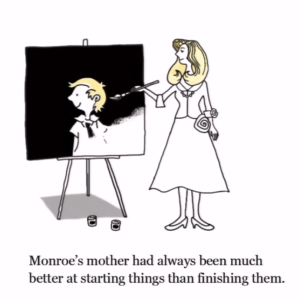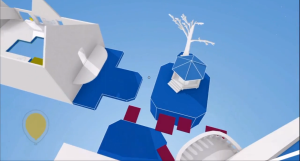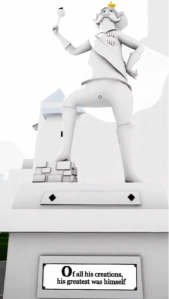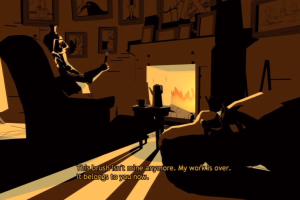White space. Black paint. These are the two components of the much discussed opening of Giant Sparrow’s The Unfinished Swan. The player is immersed in a completely white space, and must, by shooting balls of paint, splatter the contours of their environment into being. Eventually, a space emerges out of the whiteness, a space which can be navigated. While most critics have discussed this mechanic and the themes of the game through the lens of discovery, I would rather look at it from the standpoint of creation. The Unfinished Swan has a story filled with creators, from the King, to the mother figure, to the small boy Monroe, who functions as the player’s avatar. Over the course of the narrative, themes of creation become inextricably linked to the idea of self-creation, as several characters struggle with issues of identity and mortality. The narrative also mechanically and thematically ties the position of the player to these issues, and by the end of what is, on the surface, a children’s story, the player’s creative role is drawn into question, and the very act of playing is shown in a new light.

This is the opening image of the game, and hints at the way identity, like art, paintings, and stories, are created.
Before we dive into the player’s creative role, it is illuminating to look at the portrayal of the King in the game. When we first hear about the King, he is introduced as an “extremely talented” painter whose paintings form a real world, and who wants to construct the perfect kingdom. It is his world that we enter, in a space that is initially completely white. The perfectly white garden is explained by the narrator as existing because of the King’s rigid designs: because “no colour existed that was good enough for his garden,” he left it white. The player has thus stepped into the world of the King, which he has painted into being. The King’s creative drive, however, is entirely dictatorial: he wants to fulfill his own designs, regardless of the needs of others. When people begin to settle his kingdom, they struggle to live in the white space, and so they begin to paint. But the collaboration of others is unacceptable to the King, who sees the people’s work as “ruining his spotless design,” and as such outlaws paintbrushes. A later section of the game, in which the player can prompt vines to spread across part of the kingdom, also alludes to the King’s totalitarian form of controlling space. The King views these designs as aberrations, and spends a great deal of effort attempting to remove, nearly destroying his kingdom in the process, but inevitably fails. Natural development or change beyond the scope of his own designs are blasphemous to the King, and he restricts any alterations he can.
A high degree of narcissism is implicit in the King’s dictatorial relation to his creations: it is always about his vision, his design, his legacy, and any other influence is an aberration. This narcissism gets more pronounced over the course of the game. The kingdom explored by the player is riddled with the King’s sculptural self-portraits, self-made physical manifestations of how he views himself. Furthermore, when the King becomes too frustrated with his subjects’ disobedience, he decides to abandon them and create a family instead. The wife he chooses is a wife he creates in his own image, a woman who is “a female version of himself,” and who the King loves dearly. The woman created is a combination of two Greek myths: Narcissus, falling in love with his own reflection, and Pygmalion and Galatea, about an artist who falls in love with a statue he has created, and which subsequently comes to life. The intersection between these two myths leads to thematic intertwining between the narratives. It is one of the clearest cases where creation and love, as in the Pygmalion myth, are tied to self-creation and self-love, as in the Narcissus story. It is as if the King cannot distinguish between them, and the interrelation between these concepts becomes a running theme throughout the game. When his mirror-self leaves him, the King decides to make a more direct representation of himself: “a colossal monument of himself that would be his legacy for the ages.” This too he fails to create to his designs, not even succeeding in finishing the giant to-scale model. The King’s obsession with passing on his legacy through his creations always manifests as him creating mirrors or representations of himself in the world. It is through the character of the King that notions of creation and self-creation become indistinguishable in the narrative. All of the King’s creations are reflections of himself, of his desires, either implicitly or explicitly. There even stands a statue of himself in his hedge maze with the inscription “Of all his creations / his greatest was himself.”
While the King is obsessed with creating manifestations of himself, it is important that the narrative emphasizes his failure to complete these projects. He develops massive designs for himself, which he attempts to live up to, inevitably falling short. At this point, I would like to touch briefly on a well-known piece by French theorist and psychoanalyst Jacques Lacan, “The Mirror Stage as Formative of the Function of the I as Revealed in Psychoanalytic Experience.” In this essay, Lacan posits that, early in life, a child realizes that the image they see in the mirror is an image of themselves. This is an important stage leading to the development of the child’s ego, as they see a representation of themselves which is cohesive and unified, which differs from their understanding of themselves as fragmented, as a collection of discrete parts. The child, from this point on, struggles with the juxtaposition between what they feel themselves to be and what they would like to be; they always strive towards but never truly become the image of themselves in the mirror. This mirror self becomes a fiction that is imagined by the child as something they should conform to, a unified, ideal person they would like to be. For Lacan, the imagined self is a construction which is always being re-imagined based on social stimuli and personal ambition, and which the real self always falls short of or differs from.
The King’s struggle to manifest the perfect self through his creations reflects the dissonance between his two selves. He constantly has his designs fail, he is left by his wife and mirror-self, and eventually he is faced with the possibility that he won’t have a legacy at all; he muses at the end of the game that all his works that “were meant to last forever… would crumble into dust. Or be painted over by someone who would come after [him].” And while for much of his life the King would have been devastated by the realization that his legacy will be destroyed, over the course of his dream sequence he comes to terms with his personal failings and his mortality. He muses that, even though he had never finished his kingdom the way he envisioned it, and even though his works would crumble and fade, he “wasn’t sad it was all gone. [He] had fun making all that stuff. [He] would have done it anyway.” It seems that he finally begins, at the end, to accept the juxtaposition between the self he imagines himself to be, and who he is, relinquishing his dreams of immortality in the process. It is about the act of creation and self-creation, rather than the end result, and he finally finds contentment in who he is rather than who he would like to be. It is in this spirit that he is able to at last give up creative control, bequeathing his magic paintbrush to his son, Monroe.
Monroe’s creative acts are very different from those of the King, and yet they are no less about self-creation. The most immediate difference is that Monroe paints out of necessity: he must find his way through the environment and follows the swan. Beyond the reasons for Monroe’s creative acts, there is also a difference in implementation. Neither Monroe nor the player, when they first enter the game world, have a clear design, a vision of what the world should look like. Instead, creation is organic, using feedback from the environment as well as raw necessity to determine where and what to paint. Rather than attempting to prevent outside influence, external support is necessary for Monroe to advance; a wall is revealed in front of him, and so he must paint elsewhere in order to continue. There is a give and take here between the artist and the creation, between design and necessity, that was lacking in the tyrannical view of art espoused by the King. This is also apparent in the second chapter, with the mechanic of the vines. Monroe needs the vines to help him advance through the world, and while he has some control over how the vines spread, in terms of roughly directing their growth, the vines have a will of their own. And Monroe benefits from this growth, as he can progress through the game world, while the King saw nothing except a distortionary influence on his designs.
This difference in attitude is crucial, and reflects the different mentalities of the characters. Where the King holds up an ideal and strives to achieve it, inevitably falling short, Monroe feels “pretty unfinished himself” and must make sense of his new reality, both in terms of the white world he finds himself in and the recent loss of his mother. He must become a creator in order to create himself, while the King approached it in the other direction, trying to create himself by becoming a creator. When Monroe escapes the realm of the King, magic paintbrush in hand, it is implied by the narrator that he begins to cope with his loss, and expresses this in by doing “something that would have made his mother very happy. He painted.” And what he chooses to paint is his own swan, along with a few baby swans to complete the picture. He continues the work his mother was unable to finish, including the work needed to be done on himself. And while according to Lacan Monroe may never achieve the self he would like to be, at the end of the game he has at least begun to get a grip on the attempt. He is no longer lost in a world that seems empty: he has found his own creative ability, and has thrown together the rough lines of who he will be.
But what about the player? How do they fit into this theme centred on creation? In an article for the journal Games and Culture, Aylish Wood discusses the ways in which players coconstitute the game space with the game engine in a way that is recursive, i.e. in a feedback loop. That was a little wordy, so I’ll try to break it down. The player turns on the game, which actualizes the game’s source code, so that is becomes a 3D or 2D space. This is the first step in the way that the player creates the game world in concert with the game’s code. As the player navigates the game space and the series of objects provided by the game engine, the objects they encounter react and shift in terms of their relations to one another as a result of the player. For example, hostile NPCs move in particular ways as a response to the player’s movement, which in turn is a response to the environment and the actions of other objects in that environment. So there is a feedback loop: the player acts in response to environmental stimuli, and the objects in the environment readjust in response to these inputs by the player. It is a series of reactions, which takes place both in the functioning of the software and in its visual manifestation, the game world. On a less tangible level, the player also creates the environment by simply moving the camera. What exists on-screen is determined by the player’s perspective, obviously limited by the game’s possibilities, and in this way the player really does create space. Just look at glitches like pop-in. One of the reasons it is so frustrating is that it disturbs the supposed “realism” of the game by making it clear that, before the player was able to see it, there was no tree, or NPC, or house, etc. The game engine reacts to the player’s input and perspective and visual objects are created. In this sense, the player never really explores a game space, but rather they generate it.
Before directly applying this theory to The Unfinished Swan, it is interesting to look at the ways different game spaces are introduced in light of Wood’s arguments. Rather than being immersed in a fictional world, one the player is encouraged to think of as “real,” in The Unfinished Swan the opposite occurs. I’m afraid my introductory paragraph lied somewhat: we begin the game not in the white room, but in a book. Before we enter the white garden, there is a narrative introduction which centres around a book, which will reappear at the threshold between parts of the game world. When we see this book for the first time, the cover opens, and there is a blank page, until the story begins to draw and write itself. We are shown in these sequences that, first of all, we are participating in a story, in fiction, but also that the story is not something fixed, but something made, something procedural. There is an emphasis here on the creative process involved in the production of the game we are playing; this emphasis sets The Unfinished Swan apart from other video games. While so many other games try to be polished, this game wants to be unfinished, rough around the edges, so the player can see that it is something made, not something static. And by making the player aware of the unfinished aspects of the game, they are driven to look at their own part in the process of generating the game, and the story.

This is the first white space of the game, and it draws our attention to the creative process behind the story.
Looking at the gameplay itself, I think that its resonances with Wood’s theory are clear, but they merit more thorough exploration. The player in the opening gameplay sequence is asked to use their inputs to create a game space, within the limitations of the software. This is Wood’s theory of recursive space (just as a side note, this is derived from Lefebvre) in it’s most pure form. Before the player acts, there is no tangible manifestation of the game world embedded in the source code. Once the player acts by splattering paint, they begin working together with that code to create a space that, especially in The Unfinished Swan, is unique. This continues throughout the game. The way the vines grow is determined in part by the player, in part by the game engine. The way the blueprint of a house looks after the player traverses that space is determined by the possible spaces the player can build on, the possible shapes they can construct, and the player’s choices. These scenes in the game give the player a limited creative function, asking them to create a space which is their own while remaining within the boundaries of the game’s mechanics and level design. And while this aspect connects the player’s experience to spatial theories like that developed by Wood, it also thematically connects the player’s actions to that of Monroe. Of course, because Monroe is the player’s avatar, there are sure to be connections. But what is interesting is that, by putting the player in Monroe’s shoes and tying the actions of the player into the themes of creation and self-creation, the designers at Giant Sparrow give material for reflection in terms of the player’s own creative role. They show the story of the King trying to make a kingdom, they show the story of Monroe altering that kingdom and becoming a creator in his own right. Here are two agents whose actions determine the environment. The mechanics and the actions of the player fit thematically with these figures, as, by playing, they too help create the game world and story. Just like the King and his son, the player is necessary to bring the world to life, and they too are given the chance to make it their own by interacting with it in a unique way.

The player can develop this blueprint into whatever they like within the boundaries of the blue spaces.
To be frank, I love this game. I think it presents metafiction at its finest: understated, thought-provoking, and medium specific. This is a story that can’t be effectively told in a different artistic form, with themes that have unique implications because of their relations to the mechanics. It doesn’t beat you over the head with metafictional references (though there are a few, especially at the end), and yet the player is driven to consider what it means to play this game specifically as well as games in general. All aspects of The Unfinished Swan — the children’s story narrative, the limited mechanic scope, the minimalist art style, the metafictional themes — are simple without being simplistic. That is an impressive feat for a game company’s first release, and the reason that The Unfinished Swan is a game changer.


Pingback: It reminds me again and again. | i love this blog because it feels like home...
Pingback: This Year in Video Game Criticism: Farewell, 2013 » Gaming News Alerts